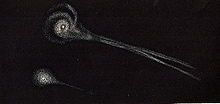Andromedids
The Andromedids are a meteor shower active from September 25th to December 6th . The radian of the Andromedids, which has a weak maximum around November 14th, is located in the constellation Andromeda ( RA 26 °, DE + 37 °).
The original comet is 3D / Biela , which is why the current is also known as Bieliden . Biela began to break up in the mid-19th century. On November 27, 1872, as the earth passed the closest point to the comet's orbit, a remarkable meteor shower was observed. Several meteors were sometimes observed here at the same time. The geocentric speed was only 16 km / s (average shooting stars have speeds of approx. 50 km / s, particularly fast ones of up to 72 km / s), which means that the meteors moved remarkably slowly in the sky.
On November 27, 1885 there was another meteor shower in which up to 300 meteors per minute were observed. No further meteor eruption has been observed since then. In the course of time, the activity of the Bieliden continued to decline, so that the current was hardly detectable. In 2011, however, increased activity was observed in the period from December 3rd to 5th, 2011, which peaked at a zenithal hourly rate of 50 meteors per hour. The radiant was in the constellation Cassiopeia (RA 18 °, DE + 56 °). According to calculations, these meteors were released from Biela during the perihelion passage in 1649. Two years later, on the night of 7/8. December 2013 an increasing activity was observed north of the Andromeda Galaxy. The falling stars that can be observed from December 1st to December 8th are now known as December-phi-Cassiopeids .
Individual evidence
- ↑ meteorshowersonline.com: Andromedids ( Memento from June 1, 2013 on WebCite )
- ↑ a b Jürgen Rendtel: Shooting stars . Urania, Leipzig 1991. ISBN 3-332-00399-2
- ^ Arxiv.org: The return of the Andromedids meteor shower , accessed December 8, 2013
- ↑ www.skyandtelescope.com: An Outburst of Andromedid Meteors , accessed January 16, 2016
- ↑ www.imo.net: December phi-Cassiopeiids shower parameters update , accessed on August 19, 2019
